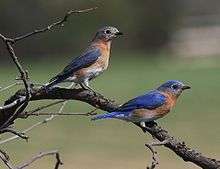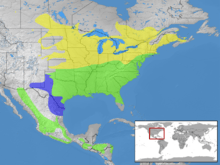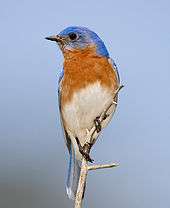Eastern bluebird
The eastern bluebird (Sialia sialis) is a small migratory thrush found in open woodlands, farmlands, and orchards. It is the state bird of Missouri[2] and New York.
| Eastern bluebird | |
|---|---|
 | |
| Pair in Michigan | |
| Scientific classification | |
| Kingdom: | Animalia |
| Phylum: | Chordata |
| Class: | Aves |
| Order: | Passeriformes |
| Family: | Turdidae |
| Genus: | Sialia |
| Species: | S. sialis |
| Binomial name | |
| Sialia sialis | |
 | |
| Geographic distribution of S. sialis Breeding range Year-round range Wintering range | |
| Synonyms | |
|
Motacilla sialis Linnaeus, 1758 | |
This species measures 16–21 cm (6.3–8.3 in) long, spans 25–32 cm (9.8–12.6 in) across the wings, and weighs 27–34 g (0.95–1.20 oz).[3][4] Eastern bluebirds are found east of the Rockies, southern Canada to the Gulf states, and southeastern Arizona to Nicaragua. The increase in trees throughout the Great Plains during the past century due to fire suppression and tree planting facilitated the western range expansion of the eastern bluebird[5] as well as range expansions of many other species of birds.[6][7][8] From 1966-2015 the eastern bluebird experienced a greater than 1.5% annual population increase throughout most of its breeding and year-round ranges, with exceptions including southern Florida and the Ohio River valley.[9]
The bright-blue breeding plumage of the male, easily observed on a wire or open perch, makes this species a favorite of birders. The male's call includes sometimes soft warbles of 'jeew' or 'chir-wi' or the melodious song 'chiti WEEW wewidoo'.[10]
Food
About two thirds of an adult bluebird's diet consists of insects and other invertebrates. The remainder is made up of wild fruits or berries. The bluebird's preferred insect prey include grasshoppers, crickets, katydids, and beetles. Other prey include earthworms, spiders, millipedes, centipedes, sow bugs, and snails.

Bluebirds feed by perching on a high point, such as a branch or fence post, and swooping down to catch insects on or near the ground. The availability of a winter food source will often determine whether or not a bird will migrate. If bluebirds do remain in a region for the winter, they group and seek cover in heavy thickets, orchards, or other areas in which adequate food and cover resources are available.
Life history

Eastern bluebirds are very social birds. At times, they gather in flocks of a hundred or more. However, they are territorial during the breeding season and may continue to defend a feeding area throughout the winter. Mating occurs in the spring and summer. A mature female typically raises two broods each season. Nests are constructed in trees within abandoned woodpecker holes or other cavities that provide adequate protection (usually several feet above ground). Construction of the nest is done primarily by the female and takes around 10 days to complete. These nests are small, cup-like structures lined with grass, feathers, stems, and hairs. Each female lays three to seven light-blue or, rarely, white eggs. The female incubates the eggs, which hatch after 13 to 16 days. The young cannot care for themselves upon hatching. The female broods the chicks for up to seven days after hatching. Fledglings then leave the nest 15 to 20 days after hatching.[4]

Both parents cooperate in raising the young, which they feed a diet consisting almost entirely of insects. Some young stay around the nest to help raise another brood. Fledglings are grayish in color, with speckled breasts. The blue color becomes much more prominent and the speckles on their breasts disappear as they mature. Bluebirds may begin breeding the summer after they are hatched.[4]
Eastern bluebirds can live for 6 to 10 years. The longest recorded lifespan for a bluebird is 10 years and five months.[11] However, most bluebirds die within their first year of life. Starvation and freezing are a danger to the young, but most threats come from other animals, including humans. Natural predators of eggs and nestlings can include eastern chipmunks, flying squirrels, American black bears, fire ants, and raccoons. Bluebirds of all ages (including adults) are threatened by rat snakes, racers, American kestrels, and domestic cats. Introduced species such as European starlings and house sparrows are competitors for nesting sites. Non-nesting adults face predation by all native species of falcons, owls, and most varieties of hawks, particularly those in the genus Accipiter. When approached by a predator, the male makes a song-like warning cry. If no male is present, a threatened female will begin to sing, hoping to attract a protective male back to the territory. Both males and females also flick their wings and warble when predators are nearby.[4]
Habitat

Eastern bluebirds tend to live in open country around trees, but with little understory and sparse ground cover. Original habitats probably included open, frequently burned pine savannas, beaver ponds, mature but open woods, and forest openings. Today, they're most common along pastures, agricultural fields, suburban parks, backyards, and even golf courses. This bird also occurs across eastern North America and south as far as Nicaragua. Birds that live farther north and in the west of the range tend to lay more eggs than eastern and southern birds.[11]
Similar species
- Western bluebird (Sialia mexicana)
- Mountain bluebird (Sialia currucoides)
See also
References
- BirdLife International (2012). "Sialia sialis". IUCN Red List of Threatened Species. 2012. Retrieved 26 November 2013.CS1 maint: ref=harv (link)
- "Missouri Revised Statutes, Section 10.010.1 - Official State Bird". Missouri General Assembly.
- "Eastern Bluebird". All About Birds. Cornell Lab of Ornithology.
- "Sialia sialis". Animal Diversity Web (ADW).
- Gowaty PA, Plissner GH. (1998). Eastern Bluebird (Sialia sialis), no. 381. In: A. Poole (ed.). The Birds of North America Online. Cornell Lab of Ornithology, Ithaca, New York.
- Livezey KB. (2009a). Range expansion of Barred Owls, part I: chronology and distribution. American Midland Naturalist 161:49–56.
- Livezey KB. (2009b). Range expansion of Barred Owls, part 2: facilitating ecological changes. American Midland Naturalist 161:323–349.
- Livezey KB. (2010). Killing barred owls to help spotted owls II: implications for many other range-expanding species. Northwestern Naturalist 91:251–270.
- "Eastern Bluebird Sialia sialis BBS Trend Map, 1966 - 2015". Patuxent Wildlife Research Center. USGS. Retrieved 2019-05-24.
- Sibley, David Allen (2000). The Sibley Guide to Birds. New York: Knopf. p. 401. ISBN 0-679-45122-6.
- "Eastern Bluebird, Life History". All About Birds. The Cornell Lab of Ornithology. Retrieved 6 June 2014.
External links
| Wikimedia Commons has media related to Sialia sialis. |
| Wikispecies has information related to Sialia sialis |
- North American Bluebird Society
- Life Histories of Familiar North American Birds: Eastern Bluebird
- BirdLife species factsheet for Sialia sialis
- Eastern Bluebird Species Account – Cornell Lab of Ornithology
- Eastern Bluebird Species Information from Bluebird Information and Awareness
- National Geographic News article Covers N.A. Breeding Bird Survey, birdhouses, bluebird recovery
- Eastern Bluebird at Northern Prairie Wildlife Research Center
- Eastern Bluebird Bird Sound at Florida Natural History Museum
- Bermuda Department of Conservation Services Bluebird Page
- Sialis.org — Resources and advice for bluebird conservation.
- "Eastern bluebird media". Internet Bird Collection.
- Eastern bluebird photo gallery at VIREO (Drexel University)
- Eastern Bluebird - Sialia sialis - USGS Patuxent Bird Identification InfoCenter
- Audio recordings of Eastern bluebird on Xeno-canto.
